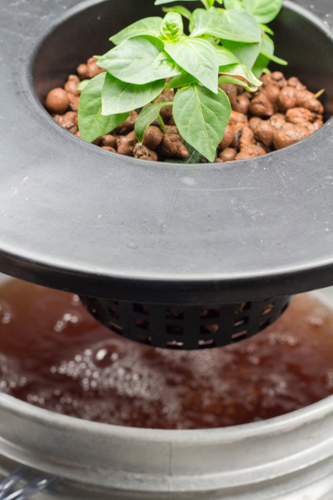DWC vs. Kratky Hydroponics: A Comparative Analysis
In the ever-evolving world of hydroponics, growers are constantly seeking the most efficient and effective methods to cultivate their crops. Deep Water Culture (DWC) and Kratky hydroponics are two popular techniques that have gained traction among hydroponic enthusiasts. Each method has its strengths and weaknesses, and the choice between DWC and Kratky depends on various factors, including the type of plants being grown, available resources, and the grower’s level of expertise.
Understanding Deep Water Culture (DWC)

DWC system has aeration to oxygenate the nutrient solution.
DWC is a hydroponic system where plant roots are suspended in a nutrient-rich solution. The roots are continuously submerged in oxygenated water, promoting rapid nutrient absorption. This method relies on the use of an air pump and airstones to maintain adequate oxygen levels in the nutrient solution, preventing root rot and promoting healthy plant growth.
Advantages of DWC:
- Faster Growth: DWC is known for its ability to accelerate plant growth. The constant availability of nutrients and oxygen allows plants to reach maturity more quickly.
- High Oxygen Levels: The submerged roots receive a continuous supply of oxygen, promoting robust root development and nutrient uptake.
- Easy Nutrient Monitoring: Growers have direct control over nutrient levels, making it easier to monitor and adjust the solution to meet the specific needs of the plants.
Exploring Kratky Hydroponics
Kratky hydroponics, named after its creator Dr. Bernard Kratky, is a passive hydroponic method. It involves growing plants in a stationary nutrient solution without the need for electricity or pumps. The nutrient solution is placed in a container, and as the plants absorb the solution, the water level gradually decreases. This method relies on the principle of air-water balance, ensuring that the roots receive both nutrients and oxygen.
Advantages of Kratky Hydroponics:
- Simplicity and Low Cost: Kratky hydroponics is known for its simplicity. It requires minimal equipment and is a cost-effective option for small-scale growers.
- Energy Efficiency: Since it operates without pumps or electricity, Kratky hydroponics is energy-efficient, making it an attractive option for growers seeking sustainability.
- Low Maintenance: The system is relatively low-maintenance, making it suitable for beginners or those with limited time for cultivation.
Comparative Analysis: DWC vs. Kratky Hydroponics
1. Scale and Complexity:
- DWC: More suitable for larger-scale operations due to the need for pumps and aeration systems.
- Kratky Hydroponics: Ideal for small-scale and hobbyist growers due to its simplicity.
2. Growth Speed:
- DWC: Faster growth due to constant nutrient availability and optimal oxygen levels.
- Kratky Hydroponics: Slower growth compared to DWC, but still efficient for certain crops.
3. Resource Requirements:
- DWC: Requires electricity for pumps and aeration, potentially higher upfront costs.
- Kratky Hydroponics: Minimal equipment and energy requirements, making it a budget-friendly option.
4. Maintenance:
- DWC: Regular monitoring and maintenance required to ensure proper functioning of pumps and aeration systems.
- Kratky Hydroponics: Low maintenance; mainly requires periodic checking and adjustment of nutrient solution levels.
Conclusion: Choosing the Right Hydroponic Method
The choice between DWC and Kratky hydroponics ultimately depends on the grower’s goals, available resources, and level of expertise. DWC is well-suited for those seeking rapid growth in a controlled environment but requires a higher initial investment and ongoing maintenance. On the other hand, Kratky hydroponics offers a simpler, cost-effective solution with lower maintenance requirements, making it an excellent choice for beginners or those with limited resources.
In the end, successful hydroponic cultivation is about finding the method that aligns with your specific needs and preferences. Whether you opt for the high-octane growth of DWC or the simplicity of Kratky hydroponics, both methods have their place in the diverse world of soil-less cultivation.
=============================================

